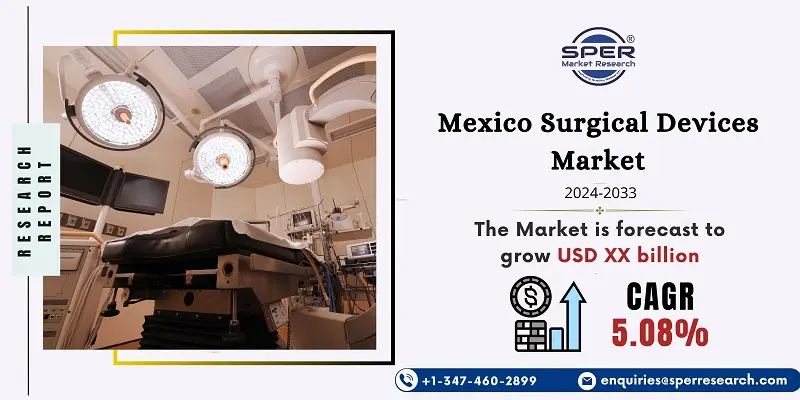
Mexico Surgical Devices Market Growth, Size, Trends, Demand, Revenue and Future Outlook
Mexico Surgical Devices Market Size- By Product, By Application- Regional Outlook, Competitive Strategies and Segment Forecast to 2033
| Published: Sep-2024 | Report ID: MEDE2444 | Pages: 1 - 108 | Formats*: |
| Category : Medical Devices | |||
- September 2022: Tecate, Mexico's Medical Device production Center of Excellence officially opened. Nordson MEDICAL is a worldwide integrated solutions partner for the design, engineering, and production of complex medical devices and components.
- October 20, 2022: Ciudad Juárez, Mexico, became the site of a new Ambu production facility. Being the company's largest plant, the new one allows Ambu to increase output and establish a stronger supply chain and access to its greatest market, North America.


| Report Metric | Details |
| Market size available for years | 2020-2033 |
| Base year considered | 2023 |
| Forecast period | 2024-2033 |
| Segments covered | By Product, By Application. |
| Regions covered | Eastern Region, Western Region, Northern Region, Southern Region |
| Companies Covered | Ambu, B. Braun Melsungen AG, Boston Scientific Corporation, Conmed Corporation, Integer Holdings Corporation, Johnson & Johnson, Medtronic PLC, Stryker Corporation, Ultradent Products, Inc, Others. |
- Healthcare Professionals
- Hospitals and Surgical Centers
- Medical Device Manufacturers
- Regulatory Agencies
- Patients and Caregivers
- Investors and Financial Analysts
- Researchers and Academics
- Distributors and Suppliers
| By Product: |
|
| By Application: |
|
- Mexico Surgical Devices Market Size (FY’2024-FY’2033)
- Overview of Mexico Surgical Devices Market
- Segmentation of Mexico Surgical Devices Market By Product (Handheld Devices, Laparoscopic Devices, Electro Surgical Devices, Wound Closure Devices, Trocars and Access Devices, Others)
- Segmentation of Mexico Surgical Devices Market By Application (Gynaecology and Urology, Cardiology, Orthopaedic, Neurology, Others)
- Expansion Analysis of Mexico Surgical Devices Market
- Problems and Obstacles in Mexico Surgical Devices Market
- Competitive Landscape in the Mexico Surgical Devices Market
- Impact of COVID-19 and Demonetization on Mexico Surgical Devices Market
- Details on Current Investment in Mexico Surgical Devices Market
- Competitive Analysis of Mexico Surgical Devices Market
- Prominent Players in the Mexico Surgical Devices Market
- SWOT Analysis of Mexico Surgical Devices Market
- Mexico Surgical Devices Market Future Outlook and Projections (FY’2024-FY’2033)
- Recommendations from Analyst
1.1. Scope of the report1.2. Market segment analysis
2.1. Research data source
2.1.1. Secondary Data2.1.2. Primary Data2.1.3. SPER’s internal database2.1.4. Premium insight from KOL’s
2.2. Market size estimation
2.2.1. Top-down and Bottom-up approach
2.3. Data triangulation
4.1. Driver, Restraint, Opportunity and Challenges analysis
4.1.1. Drivers4.1.2. Restraints4.1.3. Opportunities4.1.4. Challenges
4.2. COVID-19 Impacts of the Mexico Surgical Devices Market
5.1. SWOT Analysis
5.1.1. Strengths5.1.2. Weaknesses5.1.3. Opportunities5.1.4. Threats
5.2. PESTEL Analysis
5.2.1. Political Landscape5.2.2. Economic Landscape5.2.3. Social Landscape5.2.4. Technological Landscape5.2.5. Environmental Landscape5.2.6. Legal Landscape
5.3. PORTER’s Five Forces
5.3.1. Bargaining power of suppliers5.3.2. Bargaining power of buyers5.3.3. Threat of Substitute5.3.4. Threat of new entrant5.3.5. Competitive rivalry
5.4. Heat Map Analysis
6.1. Mexico Surgical Devices Market Manufacturing Base Distribution, Sales Area, Product Type6.2. Mergers & Acquisitions, Partnerships, Product Launch, and Collaboration in Mexico Surgical Devices Market
7.1. Mexico Surgical Devices Market Size, Share and Forecast, By Product, 2020-20267.2. Mexico Surgical Devices Market Size, Share and Forecast, By Product, 2027-20337.3. Handheld Devices7.4. Laparoscopic Devices7.5. Electro Surgical Devices7.6. Wound Closure Devices7.7. Trocars and Access Devices7.8. Others
8.1. Mexico Surgical Devices Market Size, Share and Forecast, By Application, 2020-20268.2. Mexico Surgical Devices Market Size, Share and Forecast, By Application, 2027-20338.3. Gynaecology and Urology8.4. Cardiology8.5. Orthopaedic8.6. Neurology8.7. Others
9.1. Mexico Surgical Devices Market Size and Market Share
10.1. Mexico Surgical Devices Market Size and Market Share By Region (2020-2026)10.2. Mexico Surgical Devices Market Size and Market Share By Region (2027-2033)10.3. Eastern Region10.4. Western Region10.5. Northern Region10.6. Southern Region
11.1. Ambu
11.1.1. Company details11.1.2. Financial outlook11.1.3. Product summary11.1.4. Recent developments
11.2. B. Braun Melsungen AG
11.2.1. Company details11.2.2. Financial outlook11.2.3. Product summary11.2.4. Recent developments
11.3. Boston Scientific Corporation
11.3.1. Company details11.3.2. Financial outlook11.3.3. Product summary11.3.4. Recent developments
11.4. Conmed Corporation
11.4.1. Company details11.4.2. Financial outlook11.4.3. Product summary11.4.4. Recent developments
11.5. Integer Holdings Corporation
11.5.1. Company details11.5.2. Financial outlook11.5.3. Product summary11.5.4. Recent developments
11.6. Johnson & Johnson
11.6.1. Company details11.6.2. Financial outlook11.6.3. Product summary11.6.4. Recent developments
11.7. Medtronic PLC
11.7.1. Company details11.7.2. Financial outlook11.7.3. Product summary11.7.4. Recent developments
11.8. Stryker Corporation
11.8.1. Company details11.8.2. Financial outlook11.8.3. Product summary11.8.4. Recent developments
11.9. Ultradent Products, Inc
11.9.1. Company details11.9.2. Financial outlook11.9.3. Product summary11.9.4. Recent developments
11.10. Others
SPER Market Research’s methodology uses great emphasis on primary research to ensure that the market intelligence insights are up to date, reliable and accurate. Primary interviews are done with players involved in each phase of a supply chain to analyze the market forecasting. The secondary research method is used to help you fully understand how the future markets and the spending patterns look likes.
The report is based on in-depth qualitative and quantitative analysis of the Product Market. The quantitative analysis involves the application of various projection and sampling techniques. The qualitative analysis involves primary interviews, surveys, and vendor briefings. The data gathered as a result of these processes are validated through experts opinion. Our research methodology entails an ideal mixture of primary and secondary initiatives.



Frequently Asked Questions About This Report
PLACE AN ORDER
Year End Discount
Sample Report
Pre-Purchase Inquiry
NEED CUSTOMIZATION?
Request CustomizationCALL OR EMAIL US
100% Secure Payment






Related Reports
Our Global Clients
Our data-driven insights have influenced the strategy of 200+ reputed companies across the globe.






















